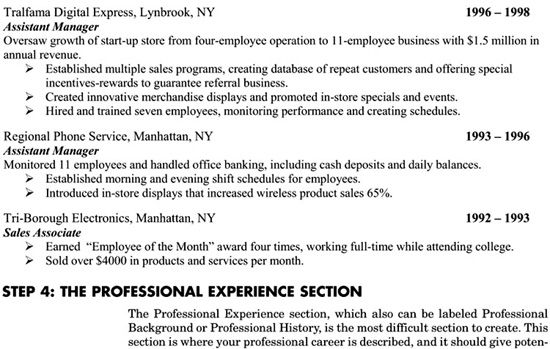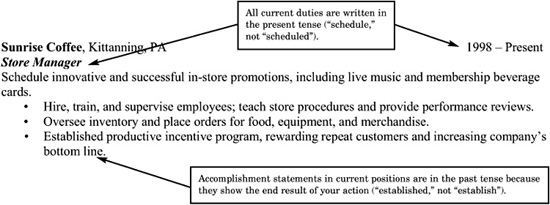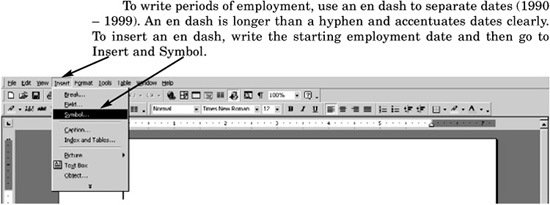The Resume.Com Guide to Writing Unbeatable Resumes (12 page)
Read The Resume.Com Guide to Writing Unbeatable Resumes Online
Authors: Warren Simons,Rose Curtis


The Professional Experience section, which also can be labeled Professional Background or Professional History, is the most difficult section to create. This section is where your professional career is described, and it should give potential
employers a clear idea of what you’ve accomplished, the industries in which you’ve worked, and the people with whom you’ve collaborated.
This section of your resume combines your
job responsibilities or duties
with targeted
accomplishment statements
. The difference between the two is that a
responsibility statement
explains the essential elements of the job and is similar to a job description. An
accomplishment statement
, in contrast, describes the particular effect you had; this can be in the form of increased efficiency, productivity, and revenues or decreased expenditures, downtime, and waste. A good tip for creating effective responsibility statements is to begin the sentence with “Responsible for” and complete the statement with a description of your general duties. Another good way to differentiate the two is to write the responsibility statement in paragraph form and the accomplishment statements as bullets, helping these significant achievements stand out on the page.
A vital component of professional resume writing is prioritizing your accomplishment statements to show a prospective employer your greatest attributes and contributions. Start with quantifiable results, such as years of experience or number of employees managed, and then move on to less significant results at the bottom of each job description.
Additionally, your resume should serve as an overview of your professional career, not take the form of an essay. Knowing what information to include and exclude is extremely important. Some areas to showcase in this section include the following:
✓
Years of experience:
Ten-year career in office management, including experience in environmental administration and government regulations. (Avoid age discrimination by never going back farther than 25 years.)
✓
Day-to-day responsibilities and tasks:
Responsible for overseeing all data entry for northwest regional sales group.
✓
Innovations or improvements for which you were responsible:
Spearheaded use of electronic record keeping, enabling real-time data storage program.
✓
People you interacted with and supported:
Provided administrative support for telemarketing group and sales associates as well as product manufacturer representatives and third-party vendors.
✓
Any awards based on performance:
Received “Employee of the Year Award,” 1995.
Writing in the correct tense is a vital part of making a clear presentation of your employment history to potential employers. Ongoing responsibilities, such as current job duties or skills that you are using currently, are written in the present tense. Promotions, accomplishments, and past results should be written in the past tense.
“Manage,” “guide,” “direct,” and “oversee” are all present-tense verbs that might apply to current responsibility statements and skills currently being used. “Managed,” “guided,” “directed,” and “oversaw” are all past-tense verbs and would apply to previous positions.
You might have a mix of present and past tense action verbs in your current position; that is acceptable in resume writing. However, be sure that all action verbs for previous positions are written in the past tense.


If you are using the chronological format, break your professional experience section into separate job descriptions, starting with your most recent employer, job title, and dates of employment. Under that information list three to eight bullets for every position.
As we discussed above, prioritizing your strongest selling points is a key to the chronological resume. For example, if you are a sales manager applying for a sales director job, your quota-shattering results and your team’s performance should be listed at the top, whereas a description of your communications skills should be listed toward the bottom. As a rule, hirers find hard statistics extremely alluring (such as sales revenue numbers), and this will maximize your resume’s success.
If you are using the functional format, your professional experience section will be divided into two to four subheadings of skill sets labeled and prioritized to target an opening. For example, “Management,” “Administration,” “Communications,” and “Customer Service” are all great umbrellas for a store manager. Regardless of your targeted profession, if you are using the functional format, remember that a hirer will look first for solutions to his or her needs. That’s why targeting these subheadings to a specific job ad is the best approach.
■
List three to five subsections in the resume, highlighting your key skills or abilities. Under each of those subsections list your achievements, duties, and successes.
■
Each subsection should be relevant to the position for which you are applying. Although this type of resume allows you to apply to numerous fields, an effective approach is to target each opening specifically.
■
An excellent way to strengthen bullets is to demonstrate how you’ve applied your talents to leverage results. This is called a
“cause-and-effect”
relationship and is used to create effective accomplishment statements. Here is an example: “Used extensive research skills to identify and purchase less expensive equipment, saving company $2000 per quarter.” By showing how your skills are applied to situations, you translate your actions into vibrant accomplishments.
For many professionals one of the most common mistakes in writing a resume is to signify dates of employment by using the month-year combination (mm/yy or 12/98). Avoiding that practice can make a sporadic work history, which is common but usually detrimental to a resume, appear seamless. Omitting months therefore can camouflage potential red flags that could eliminate you from consideration.
Executives and professionals with over five years of experience usually define their periods of employment by using only years. For these professionals the need to include months becomes less important as their careers progress.


PROFESSIONAL EXPERIENCE
XYZ C
OMPANY
, N
EW
Y
ORK
, NY
2001 – P
RESENT
Director of Sales Engineering and Product Management (IT)
for privately owned provider of Internet security applications. Manage and monitor META product development and support technologies.
• Worked with three-member management team to extensively develop and refine companywide networking functional model, including architecture and engineering.
• Created and implemented sales strategies for eight-member sales team in four-state territory; oversaw closing of up to 15 new accounts weekly.
• Instrumental in negotiating and securing high-dollar contracts, including $350,000 from state of North Carolina.
• Established and built critical alliances and partnerships.
• Conducted average of five product demonstrations/presentations weekly.
• Developed and produced curriculum and technical guides for initial and ongoing training of sales personnel, engineers, and customers.
XYZ C
OMPANY
, N
EW
Y
ORK
, NY
1998 – 2001
Computer Consultant.
Managed network and 30 workstations with outside contractors. Troubleshot systems and developed new computer-related solutions.
• Assisted users with technical support; optimized systems to ensure overall efficiency.
• Wrote comprehensive employee manual for newly implemented software application.
SKILLS AND ACCOMPLISHMENTS
Business and Operations
■
Direct and monitor warehousing and retail facility activities in world-class enterprise.
